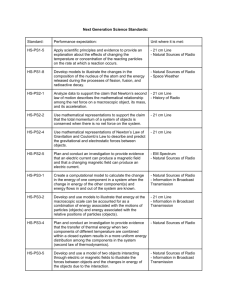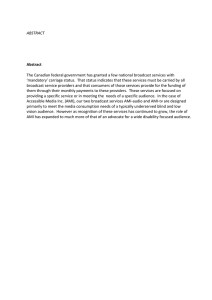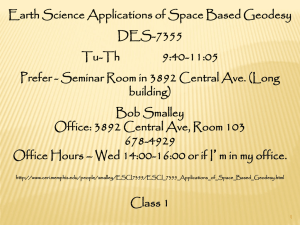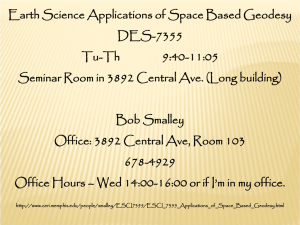Next Generation Science Standards: Standard: Performance expectation:
advertisement
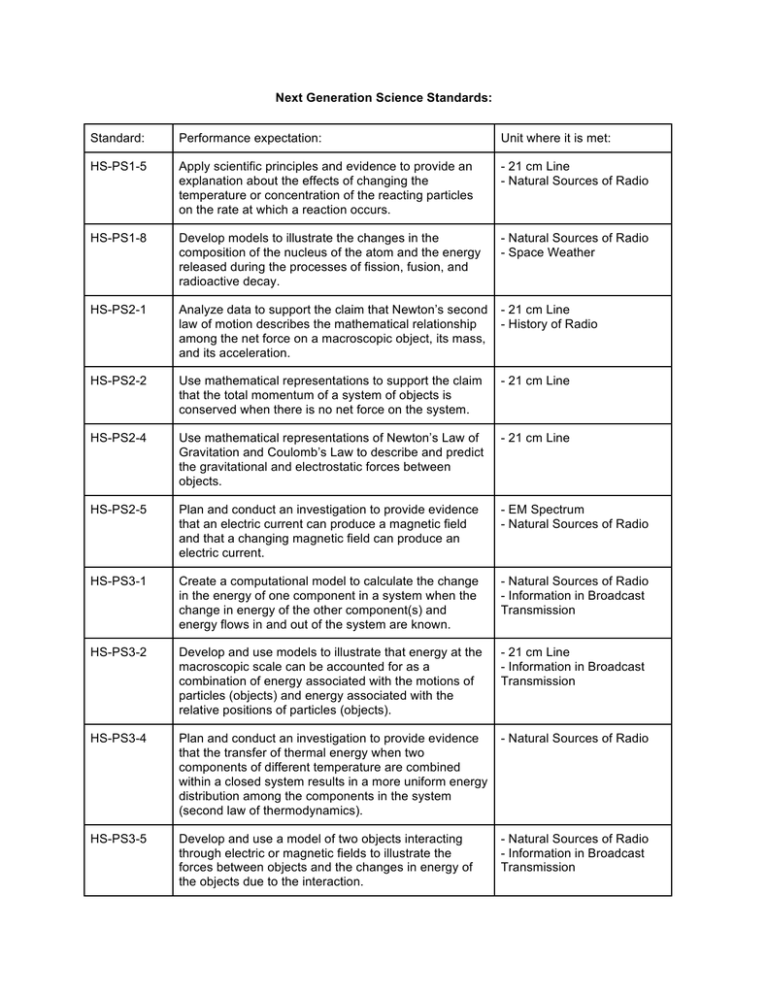
Next Generation Science Standards: Standard: Performance expectation: Unit where it is met: HS-PS1-5 Apply scientific principles and evidence to provide an explanation about the effects of changing the temperature or concentration of the reacting particles on the rate at which a reaction occurs. - 21 cm Line - Natural Sources of Radio HS-PS1-8 Develop models to illustrate the changes in the composition of the nucleus of the atom and the energy released during the processes of fission, fusion, and radioactive decay. - Natural Sources of Radio - Space Weather HS-PS2-1 Analyze data to support the claim that Newton’s second law of motion describes the mathematical relationship among the net force on a macroscopic object, its mass, and its acceleration. - 21 cm Line - History of Radio HS-PS2-2 Use mathematical representations to support the claim that the total momentum of a system of objects is conserved when there is no net force on the system. - 21 cm Line HS-PS2-4 Use mathematical representations of Newton’s Law of Gravitation and Coulomb’s Law to describe and predict the gravitational and electrostatic forces between objects. - 21 cm Line HS-PS2-5 Plan and conduct an investigation to provide evidence that an electric current can produce a magnetic field and that a changing magnetic field can produce an electric current. - EM Spectrum - Natural Sources of Radio HS-PS3-1 Create a computational model to calculate the change in the energy of one component in a system when the change in energy of the other component(s) and energy flows in and out of the system are known. - Natural Sources of Radio - Information in Broadcast Transmission HS-PS3-2 Develop and use models to illustrate that energy at the macroscopic scale can be accounted for as a combination of energy associated with the motions of particles (objects) and energy associated with the relative positions of particles (objects). - 21 cm Line - Information in Broadcast Transmission HS-PS3-4 Plan and conduct an investigation to provide evidence that the transfer of thermal energy when two components of different temperature are combined within a closed system results in a more uniform energy distribution among the components in the system (second law of thermodynamics). - Natural Sources of Radio HS-PS3-5 Develop and use a model of two objects interacting through electric or magnetic fields to illustrate the forces between objects and the changes in energy of the objects due to the interaction. - Natural Sources of Radio - Information in Broadcast Transmission HS-PS4-1 Use mathematical representations to support a claim regarding relationships among the frequency, wavelength, and speed of waves traveling in various media. - 21 cm Line - EM Spectrum - Geodesy - Natural Sources of Radio HS-PS4-3 Evaluate the claims, evidence, and reasoning behind behind the idea that electromagnetic radiation can be described either by a wave model or a particle model, and that for some situations one model is more useful than the other. - EM Spectrum - Information in Broadcast Transmission HS-PS4-4 Evaluate the validity and reliability of claims in published materials of the effects that different frequencies of electromagnetic radiation have when absorbed by matter. - EM Spectrum - Natural Sources of Radio - 21 cm Line HS-PS4-5 Communicate technical information about how some technological devices use the principles of wave behavior and wave interactions with matter to transmit and capture information and energy. - History of Radio - Information in Broadcast Transmission HS-ESS1-1 Develop a model based on evidence to illustrate the life span of the sun and the role of nuclear fusion in the sun’s core to release energy in the form of radiation. - Natural Sources of Radio HS-ESS1-2 Construct an explanation of the Big Bang theory based on astronomical evidence of light spectra, motion of distant galaxies, and composition of matter in the universe. - 21 cm Line - Natural Sources of Radio HS-ESS2-2 Analyze geoscience data to make the claim that one change to Earth's surface can create feedbacks that cause changes to other Earth systems. - Geodesy HS-ESS2-4 Use a model to describe how variations in the flow of energy into and out of Earth’s systems result in changes in climate. - Geodesy - Space Weather HS-ESS3-5 Analyze geoscience data and the results from global climate models to make an evidence-based forecast of the current rate of global or regional climate change and associated future impacts to Earth systems. - Geodesy - Space Weather HS-ESS3-6 Use a computational representation to illustrate the relationships among Earth systems and how those relationships are being modified due to human activity. - Geodesy
